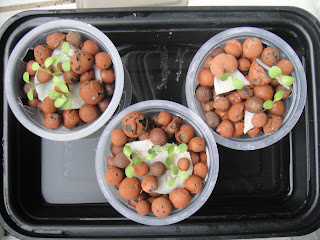 |
| William helpfully holds the tubing |
This post marks the conclusion of my hydroponics blogs. It is time to connect through to the real world of WindowFarms.
http://our.windowfarms.org/2012/05/06/hydroponics-for-dorks-their-dogs/
There! Done! This blog is now live.
The plants have been growing happily this week. I have to keep rotating the fruit cup pots because they are now very lanky and bend dramatically towards the light every 24 hours. I decided against putting them on a timer because I like to check in and turn them. If the timer watered the plants then I would not be encouraged to look at the little lettuces as much as I currently do.
To be perfectly honest, I have not been doing very much for the hydroponics lately. But this was a planned lapse. Last week was dedicated to another (much more significant) environmental commitment. Our school was awarded the 4th in the nation Green Flag environmental award from EcoSchools! Just like the seeds have had to be tended before they are ready to be harvested, finally being awarded the Green Flag was the crowning glory concluding two years of exceptionally hard work.
Last week was full of very late nights preparing final touches for the visits scheduled for Friday - and hence the seeds took a momentary back seat.
On Friday, Congresswoman Niki Tsongas, Senator Jamie Eldridge, Representative Jen Benson, our Superintendent Dr Mills, Principal Dr Callen and about 200 other community members, teachers, and students celebrated our environmental achievement.
I was proud to say that the basil on the pizza served at the ceremony was grown at the school via Mr Clinton's hydroponics systems.
Great link to a video about the festivities:
http://acton.patch.com/articles/video-abrhs-receives-green-flag-award#video-9842411
As if Friday was not enough, early the next morning, I spoke at our town's water district centennial celebration. This event helped me to consolidate my belief that hydroponics gardening is exceptionally beneficial. We analysed maps of Acton's land and water use from 1912 and compared them to parallel maps from 2012. In 1912, 70% of Acton's land was farm land. Our per capita water usage was 90 gallons per day. Now in 2012, only 10% is used for agriculture. Our per capita usage dropped to 65 gallons. One of the main reasons that our water usage fell is due to the shift away from agricultural practices. Modern agriculture is the second largest draw of water usage in the world. If people converted to hydroponics gardening, human's water footprint would dry up.
It was a bittersweet moment when the Green Flag ceremony ended. In that moment it seemed as if everything I had been working so tirelessly on for two years had suddenly ended. Just like that - it was done. But this weekend I realized that my environmental work was never going to be done. It would not end until I wanted to be done.
I do not give up until I have achieved what I set out to do.
In that case, my work is far from over.
After the water ceremony on Saturday, I attended a 350.org CAN rally in Concord. What originally looked like a fuddy-duddy gathering of people dressed up as rainforest animals quickly shifted to a scientific and life changing presentation. A number of people were invited to the microphone to talk for 4 minutes about their 'dot' in the Connect the Dots campaign. For those of you who are not up to date with 350.org, it is a nonprofit, international climate change activism organization which is working to reduce the parts per million molecules of carbon dioxide back to 350 - the sustainable level. The Connect the Dots campaign gathers seemingly unrelated events such as extreme weather, famines, rising sea level, student activism (my dot!), corporations, gender discrepancies, and Thoreau and links them together to climate change. I was surprised and ushered to the podium where I gave an impromptu speech about students' role in the climate crisis. Apparently it was successful because I was rewarded with a standing ovation and asked to continue speaking beyond the time limit. A man followed my talk who absolutely blew me out of the water. He works for the Red Cross Climate Center and spends half of his time traveling to third worlds countries affected by climate change. He spoke to the need of having hard data to predict where the next big storm will strike. Immediately after his presentation he made a beeline in my direction and we began a long conversation about climate activism. I will be working as his assistant this summer in predicting where the Red Cross needs to send aid before El Nino wreaks havoc.
It is not over.
My environmental work is just beginning.




































